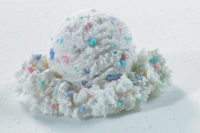As manufacturers consider more appealing alternatives to replace milkfat, one that shows considerable promise is rice starch. A six month research project undertaken by A&B Ingredients, Fairfield, N.J., concluded with a sensory panel determining that reduced-fat ice cream made with natural, waxy rice starch and 6% milkfat was comparable in quality, flavor, taste and texture to regular ice cream containing 10% milkfat.
The small granule size and soft gels of rice starch create a creamy texture that replaces the texture and mouthfeel of milkfat, while enabling manufacturers to keep an all-natural and reduced-fat label. A wide variety of rice starches can be used to achieve this, all with slightly different textural characteristics. They all have excellent freeze/thaw stability, viscosity and melt characteristics. The properties of modified rice starches also make them appropriate for the percentage of fat required in low-fat ice cream.
Rice starch does not mask or interfere with flavor and, in fact, can enhance the sweetness of ice cream. It is also less expensive than milkfat. This can be critical in today's competitive market where a few extra cents profit per gallon can make all the difference to manufacturers.
"The milk industry is a volatile market and the prices of milkfat can fluctuate significantly," says Barbara Ulen, technical sales mgr., A&B Ingredients. "When milkfat prices are high, using rice starch can result in substantial savings. But even when milkfat prices are low, rice starch is still more economical. And because 0.5% rice starch can replace 2.0% milkfat, less product is required, further lowering the cost."
Because rice starches impart a creaminess that closely resembles milkfat, it has long been used in a variety of dairy applications including flavored milks, yogurts, whipped toppings and frozen desserts to reduce fat content and maintain a vegetarian or kosher label. Rice starch can also reduce the fat content in frozen yogurt, frozen custard and ice cream novelties.
For more information, call 973/227-1390, or visit www.abingredients.com.


